DAEWOO ERF365, ERF396NIS, ERF364M, ERF 397 A User Manual
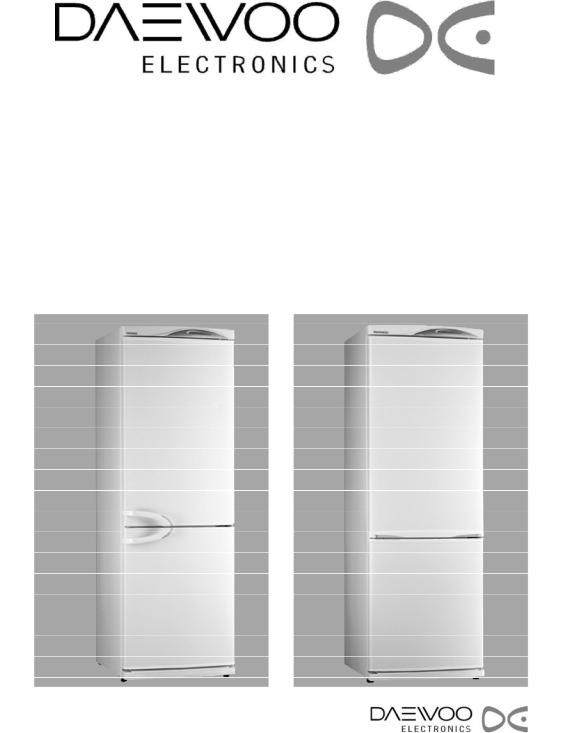
• ENGLISH |
1 |
|
|
|
• ESPAÑOL |
7 |
|
|
|
• FRANÇAIS |
13 |
|
|
|
• ITALIANO |
19 |
|
|
|
• NEDERLANDS |
25 |
|
|
|
• PORTUGUES |
31 |
|
|
|
|
|
|
|
|
Models: ERF-33.M..., ERF-34.M..., ERF-36.M..., ERF-38.M...,
ERF-39.M..., ERF-40.M...., ERF-41.M..., ERF-300
GRIP HANDLE HIDDEN HANDLE

.
.
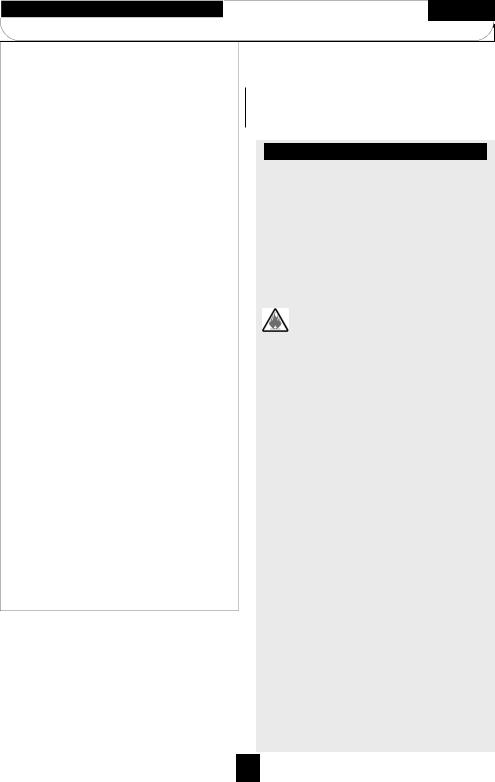
1

English
•When you open or close the door, the articles may fall and cause personal injury or material damage.
Do not store pharmaceutical products, scientific material or other temperature-sensitive products in the refrigerator.
•Products that require strict temperature controls must not be stored in the refrigerator.
Do not let a child hang from the door.
Do not touch any containers and food in the freezer with wet hands.
•It may cause frostbite.
Remove any foreign matter from the power plug pins.
•Otherwise, there is a risk of fire.
Do not insert your hand into the bottom area of appliance.
•Any sharp edges may cause personal injury.
After unplugging the appliance, wait for at least five minutes before plugging it again to the wall socket.
•Abnormal operation of the freezer may cause material damage.
If the appliance is not be used for a long period of time, pull out the power plug.
•Any deterioration in the insulation may cause fire.
Do not let children touch or play with the control panel on the front of the appliance.
•Do not allow children to play with this appliance.
•Do not stand or lean on the base panel, pull-out parts, door and so on.
•Repairs and maintenance of the appliance should only be performed by a qualified technician. Incorrect repairs by an unqualified person are a potential source of danger that may have critical consequences for the user of the appliance.
•Never put ice cubes or ice lollies straight from the freezer into your mouth. (The low temperature may cause “cold burns”.)
CAUTION
The refrigerant used in fridge / freezers and the gases in the insulation material require special disposal procedures. Ensure that none of the pipes on the back of the appliance are damaged prior to disposal.
DISPOSAL
INSTALLING THE FRIDGE / FREEZER
1.Allow an adequate space and install the fridge / freezer on a firm, level floor.
•If the appliance is not level, there may be unusual noises and poor cooling.
2.Clean the fridge / Freezer
•Wipe and clean the inside and outside of appliance with a damp cloth.
3.Plug the fridge / freezer into a wall socket used exclusively by this appliance.
•This appliance must be properly earthed.
4.Place the food in the fridge / freezer.
•It is recommended that you wait for the appliance to cool for 3~4 hours before storing food in it.
5.Keep 60 mm of space between the refrigerator and the back wall.
•Insufficient space causes the noise of vibration, weakening of refrigerating power and the waste of electricity
6.The electrical plug must be accessible without moving the set.
7.For ambient temperature below 10ºC, the perfect performance of our refrigerator can not be achieved.
WARNING
Use of an earthed socket exclusively for the appliance:
•If you are using a socket with an earthed terminal, you do not require a separate earthed connection.
Use of a non-earthed socket:
•Connect the “earthed wire” to the steel plate and bury it at depth of at least 25cm in the ground.
LEVELING
If the front of the appliance is slightly higher than the rear, the door can be opened and closed more easily.
PREPARING THE FRIDGE / FREEZER
To prepare your appliance for use and check that it is running correctly, take the following steps.
1.Install removed all shelves and compartments during transport in the correct positions.
2.Clean the fridge/freezer and accessories to remove any dust that accumulated during packing and shipping.
3.The interior light should be turned on when the refrigerator door’s opened.
4.Set the temperature control to the coldest temperature and let the refrigerator operate for one hour. The freezer should get slightly chilled and the motor should run smoothly with a soft hum and no noise. Your fridge / freezer is operated by a compressor which switches “on and off” to maintain the internal temperature. When the compressor is new, it requires running in for a period of up to five months. During this period, it may be slightly noisy. This is quite normal and does not represent a fault.
5.Store food once the temperature in the refrigerator is sufficiently low. It takes a few hours after starting the refrigerator to reach the proper temperature.
If the appliance does not operate correctly, check the electricity supply. If the problem persists, contact your dealer.
2
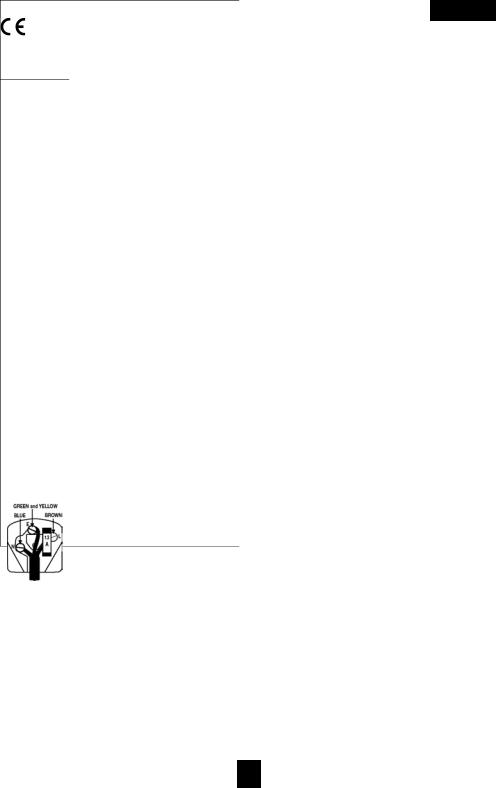
This product has been designed, constructed and marketed in accordance with EU directives 2006/95, 2004/108 and 96/57.
Please read this manual carefully to ensure maximum satisfaction from your appliance. Keep the manual in a safe place for future reference. For drawings referenced in the text below, see flap at back of the manual.
ABOUT THIS PRODUCT
■This product is designed for domestic household use only.
■Use the 4-star freezer compartment
-to freeze fresh and cooked foods,
-to store deep-frozen and frozen products,
-to make ice-cubes.
■Use the refrigerator compartment
-to store fresh foods,
-to cool drinks.
■The freezer and refrigerator compartments defrost automatically.
■Owing to cool air circulation (multi-airflow system) an even temperature is maintained on every shelf of the refrigerator compartment. The low temperature compartment is specially designed to extend nutritional value and original freshness of the food.
BEFORE CONNECTING TO THE MAINS
1.Wait 2 hours after delivery before you connect the appliance to the power supply, in order to ensure trouble-free operation.
2.In the UK only. Electrical connections:
-Check that the voltage on the rating plate (8) corresponds to the voltage in your home.
-The wires of the mains lead fitted to this appliance are coloured in accordance with the following code:
GREEN and YELLOW = EARTH (GREEN or GREEN and YELLOW)
BLUE = NEUTRAL (BLACK)
BROWN = LIVE (RED)
As the colours of the wires in the mains lead fitted to this appliance may not correspond with the coloured markings identifying the terminals in the plug, proceed as follows:
-The wire which is coloured GREEN and YELLOW must be connected to the terminal in the plug which is marked
with the letter “E” or by the earth symbol (  ) or coloured GREEN or GREEN and YELLOW.
) or coloured GREEN or GREEN and YELLOW.
-The wire which is coloured BLUE must be connected to the terminal which is marked with the letter “N” or coloured BLACK.
-The wire which is coloured BROWN must be connected to the terminal which is marked with the letter “L” or coloured RED.
English
some models).
If the terminals in the plug are unmarked or you are in any doubt as to the correct connections, consult a qualified electrician.
3.In the UK only. Moulded plugs:
-Applicable only if moulded plug is fitted.
-Should it be necessary to remove a moulded on plug from the mains cable, it should be cut off and replaced with a suitable replacement.
-The moulded plug cannot be used for any other appliance, therefore remove the fuse and dispose immediately and safely to prevent anyone, especially children, from plugging it into a wall socket, which will create a safety hazard.
3
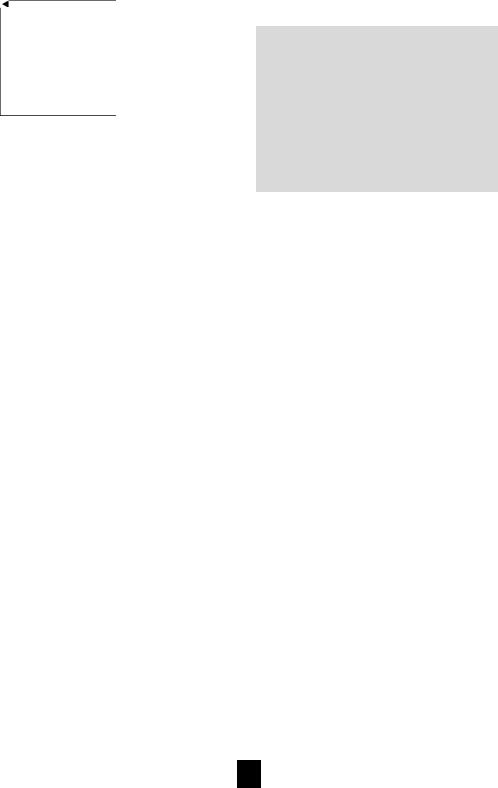
English
-Should the mains lead ever require a replacement, it is essential that this operation be carried out by a qualified electrician and should only be replaced with a flexible cord obtained from the manufacturer.
-After replacement of a fuse in the plug, the fuse cover must be refitted. If the fuse cover is lost a replacement cover must be obtained. The colour of the correct replacement fuse cover is that of the coloured insert in the base of the plug or the colour that is embossed in words in the base of the plug recess or elsewhere on the plug. Always state this colour when ordering a replacement fuse cover.
-Only 13 amp. replacement fuses which are ASTA approved to BS 1362 should be fitted.
4.Check the rating plate (8) for voltage information.
5.The socket should be easily accessible and not directly behind the appliance.
6.Electrical connections must be made in accordance with local regulations. The appliance must be earthed as described by law (connected through a properly earthed plug and socket). The manufacturer rejects all liability for injury to persons and animals or damage to property resulting from failure to comply with this requirement.
7.A 10A fuse or one of a higher value must be used in the socket circuit.
8.If the appliance plug and the wall socket are incompatible, the socket must be replaced by a qualified electrician.
9.If the supply cord is damaged, it must be replaced by the manufacturer or his service agent or a similarly qualified person in order to avoid hazard.
10.Do not use extension leads or multiple adapters, etc.
11.In some countries a plug has to be fitted. Make sure that the installation and electrical connections are performed by a qualified technician in compliance with the manufacturer’s instructions and current local safety regulations. The wires in the mains lead are coloured in accordance with the following code:
-green/yellow = earth
-blue = neutral
-brown = live.
DISCONNECTION
Note: does not apply in the UK.
Electrical disconnection: remove the plug from the mains, or (if applicable) disconnect the two-pole circuit breaker upstream from the socket.
PROTECTING THE ENVIRONMENT
-The packaging may be completely recycled, as confirmed by the recycling symbol; follow local disposal regulations.
-The appliance is manufactured from reusable materials.
-When you decide to scrap this product, please check the cable to be disconnected from the mains. Then cut off the cable and dispose of the product according to local waste disposal laws.
-This product is free of CFC’s (cooling circuit contains R134a or R-600a). Check the compressor label on the rear of the appliance or the rating label inside the fridge to see which refrigerant is used for your refrigerator.
IMPORTANT
1.Although this product was carefully checked before packing, please check the product:
-for damage;
-for correct closing of the doors.
Complaints must be reported to your retailer within 24 hours of delivery.
2.Installation instructions (7 drawings below).
3.Keep potentially hazardous packing materials (plastic bags, etc.) out of reach of children to prevent the risk of trapping
and suffocation.
Check for damages and correct |
Not in the vicinity of a heat source. |
closing of the doors. |
|
Keep room dry and well ventilated. |
Do not obstruct the top of refrigerator |
|
in order to keep enough ventilation. |
Clean interior with a damp cloth. |
Best room temperature range - |
|
+16°C to +32°C. |
Wait 2 hours before connecting to the mains.
4
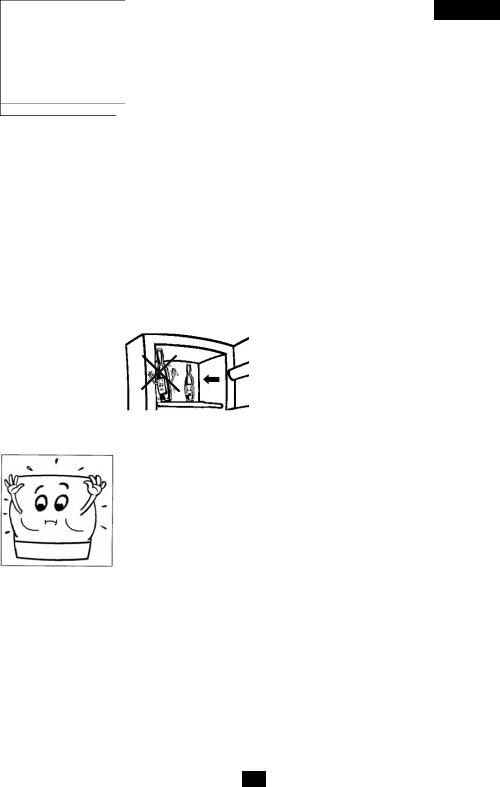
GENERAL RECOMMENDATIONS
Keep air vents open.
Ice cubes and ice lollies straight out of the freezer are too cold for consuming.
They may cause ‘cold’ burns.
Always unplug before cleaning and servicing.
Avoid food overload inside refrigerator. Do not block the air ducts with food. This would affect to the performance of the refrigerator.
No glass bottles in the freezer compartments. The bottles might burst.
Do not allow children to play or hide in the refrigerator to prevent the risk of trapping and suffocation.
Do not storage too much food in the front area of the shelves.
If the supply cord is damaged, it must be replaced by the manufacturer or its service agent or a similarly qualified person in order to avoid a hazard.
HOW TO USE THE REFRIGERATORCOMPARTMENT
Connet the lead to the mains. ( At least wait 2 hours after delivery: refer to section ”Before connecting to the mains) Food can be stored after 3 to 4 hours cooling.
- the interior light switches on when the door is opened;
English
"MID": normal storing temperature "HIGH": colder than position "MID"
“COOLING OFF”: The cooling system stops working (only the lamp is working).
Note: When you set ”refrigerator and freezer temperature control knob”(5) LOW, MID, and HIGH then the temperature of the refrigerator and freezer are automatically adjusted.
NOTES ON FREEZING AND STORAGE
1.Follow storage times indicated by the frozen food manufacturer. Make sure that the packaging is undamaged.
2.Save energy: minimize opening of the door by storing identical food items together.
3.Items suitable for freezing: meat, poultry, fresh fish, vegetables, fruits, dairy products, bread, baked goods, precooked meals.
4.Items not suitable for freezing: lettuces, radishes, grapes, whole apples and pears, fatty meats.
5.When you freeze food yourself, pack it in appropriate quantities. In order to freeze food right through do not exceed the following quantities to best preserve the quality:
-fruit and vegetables: up to 1 kg,
-meat: up to 2.5 kg.
6.Blanch vegetables after washing and cutting them. (2-3 minutes in boiling water; then quickly cool them down in cold water. When you use a steamer or microwave oven, follow the operating instructions).
7.Keep packs dry in order to avoid them freezing together.
8.Freeze fresh food separately from already frozen foods.
9.Do not salt or season fresh food or blanched vegetables before freezing. Other foods may be lightly salted or seasoned. The intensity of flavour of some spices can change.
10.Use materials or containers specially suitable for freezing in order to avoid loss of quality during defrost.
11.Write contents and date of freezing on the packs. Do not exceed the storage time indicated in order to preserve quality.
12.Do not freeze bottles or cans with carbonated drinks as they might burst.
13.Take out as much food as is immediately required for thawing. Prepare it as soon as possible after thawing.
WHEN PURCHASING FROZEN FOOD
1.Make sure that the packaging is undamaged (damage may have caused the food to deteriorate). Bulging packs or packs which are marked with liquid stains could have been improperly stored and may have been partially thawed.
2.Leave frozen food purchases until last and transport the items in insulated bags.
3.Place the items in the freezer as soon as possible.
4.Do not refreeze partially thawed food. Consume it within 24 hours.
5.Observe the date of consumption and storage information.
- the compressor operates and starts cooling;
The suitable storage temperature for fresh food is provided in the "MID" position at an ambient temperature of 16 ~ 32ºC.
REFRIGERATOR AND FREEZER TEMPERATURE CONTROL KNOB (5) SEE FLAP AT BACK OF MANUAL.
(Knob is located inside the refrigerator compartment.)
"LOW": warmer than position "MID"
CLEANING
1.Always disconnect the appliance from the mains supply.
2.Do not use abrasives. Periodically clean with a sponge dampened in lukewarm water. A neutral pH detergent may be used. Rinse and dry with a soft cloth.
3.Wipe the outside with a soft cloth dampened in water.
4.Periodically clean the front grille and the radiator at the back
5 |
with a vacuum cleaner or a brush. |
|

English
PROLONGED DISUSE |
APPLIANCE PACKAGING INFORMATION |
||
1. Empty the refrigerator and freezer compartments. |
All material are environmentally sound! They can be dumped or |
||
2. Unplug the appliance from the mains. |
burned at an incinerating plant without danger! |
||
3. Clean and dry both compartments. |
About the materials: The plastics can be recycled and are |
||
4. Leave the doors open to prevent the formation of unpleasant |
identified as follows: |
||
odours. |
|
■ PE : for polyethylene, e.g. the outer covering and the bags in |
|
|
|
the interior. |
|
AFTER SALES SERVICE |
■ PS : for polystyrene foam, e.g. the pads, which are all free of |
||
chlorofluorocarbon. |
|||
Before contacting our After Sales Service Department: |
|||
The carton parts are made from recycled paper and should be |
|||
1. Try to remedy the problem (please read section “trouble |
|||
disposed of at a waste-paper recycling collection location. |
|||
shooting guide”). |
|||
|
|||
2. Restart the appliance to check whether the fault repeats. If |
DISPOSAL OF OLD APPLIANCES |
||
the malfunction persists, switch off the appliance and try |
|||
again after an hour. |
For environmental reasons, refrigeration appliances must be |
||
disposed of properly. This applies to your old appliance, and -at |
|||
3. If the malfunction still persists, then contact our Customer |
|||
the end of its service lifefor your new appliance as well. |
|||
Service, specifying: |
|||
Warning! Before disposing of old appliances make them |
|||
- the nature of the problem, |
|||
inoperable. Remove plug from mains, server the power cable, |
|||
- the appliance model number, |
|||
remove or destroy any snap or latch closures. This eliminates the |
|||
- the service number (please see the rating plate 8), |
|||
danger that playing children lock themselves into the appliance |
|||
- your full address, telephone number and area code. |
|||
(danger of suffocation!) or place themselves into other life- |
|||
|
|
||
Note: door opening direction changes carried out by our Customer |
endangering situations. |
||
|
|||
Service are not covered by the terms of guarantee. |
Disposal: |
||
|
|
||
|
|
• The appliance may not be disposed of with domestic waste or |
|
TROUBLESHOOTING GUIDE |
bulky refuse. |
||
1. The appliance does not work. Check: |
• The refrigerant circuit, especially the heat exchanger at back of |
||
the appliance, may not be damaged. |
|||
- power failure, |
|||
• Information concerning collection schedules or locations can |
|||
- properly inserted plug, |
|||
be obtained from the local disposal authorities or town hall. |
|||
- (if applicable) connection of the two-pole circuit breaker, |
|||
|
|||
- damage to the mains lead, |
|
||
- correct setting of the temperature controls (5). |
NOTICE |
||
2. The temperature inside the compartments is not low |
|||
|
|||
enough. Check for: |
The lamp of the refrigerator can be switched off even though the |
||
- |
closure of the doors, |
||
doors are not completely closed. |
|||
- installation near a heat source, |
|||
|
|||
- correct setting of the refrigerator/freezer control knob (5), |
Note: The edge of the refrigerator door and the front side of the |
||
- inhibited air circulation. |
refrigerator cabinet may be hot. This is normal and intended to |
||
3. The refrigerator compartment temperature is too low. |
prevent the formation of condensation. |
||
Check for: |
Gurgling noises etc. inside the refrigerating circuit are normal. |
||
- correct setting of the temperature controls (5).
4.The internal light does not work. Refer to point 1 and then:
- unplug the appliance from the mains, |
-o0o- |
|
|
||
- check the bulb and replace if necessary (max.15W). |
This appliance is not intended for use by persons (including |
|
- to change the lamp first remove the window lamp by |
children) with reduced physical, sensory or mental capabilities, |
|
pushing lower part upward and pulling forward. |
or lack of experience and knowledge, unless they have been given |
|
- take out the lamp and replace it for a new one. |
supervision or instruciton concerning use of the appliance by a |
|
- finally set again window lamp on its place. |
person responsible for their safety. |
|
English |
||
|
Disposal of Used Electrical & Electronic Equipment
The meaning of the symbol on the product, its accessory or packaging indicates that this product shall not be treated as household waste. Please, dispose of this equipment at your applicable collection point for the recycling of electrical & electronic equipments waste. In the European Union and Other European countries which there are separate collection systems for used electrical and electronic product. By ensuring the correct disposal of this product, you will help prevent potentially hazardous to the environment and to human health, which could otherwise be caused by unsuitable waste handling of this product. The recycling of materials will help conserve natural resources. Please do not therefore dispose of your old electrical and electronic equipment with your household waste. For more detailed information about recycling of this product, please contact your local city office, your household waste disposal service or the shop where you purchased the product.
6

GUARANTEE CONDITIONS
We DAEWOO, undertake that if within 12 months from the date of purchase, this DAEWOO appliance or any part there of is proved to be defective by reasons only of faulty workmanship or materials, we will, at our option repair or replace the same FREE OF ANY CHARGE of labour, materials or carriage on conditions that:
The appliance has been correctly installed and used only on the electricity supply stated on the rating plate.
The appliance has been used for normal domestic purposes only and in accordance with the manufacturers operating and maintenance instructions.
The appliance has not been serviced, maintained, repaired, taken apart or tampered with, by any person NOT authorized by DAEWOO.
All service work under this guarantee must be undertaken by a DAEWOO service representative or authorized agent.
Any appliance or defective part replaced shall become the property of DAEWOO.
This guarantee is in addition to your statutory and other legal rights.
EXCLUSIONS:
This guarantee does not cover:
Damage or calls resulting from transportation, improper use or neglect, the replacement of any light bulbs or removable parts of glass or plastic.
The light bulb is not covered by this warranty.
Cost incurred for calls to put right an appliance which is improperly installed or calls made outside the United Kingdom.
Appliance found to be in use with in a commercial environment, plus those which are subject to rental agreements.
Products of DAEWOO manufacture which are not marketed by DAEWOO Electronics Sales UK Ltd.
EEC Countries. The standard guarantee is applicable but subject to the owners responsibility and cost to ensure the appliance meets the standards set by the country of which the product is taken. The DAEWOO Electronics Sales office in the country, will be pleased to advise further.
Should you require after sales service for this product, please contact DAEWOO Electronics Sales, Customer Services department on 01189 252530, or the dealer you purchased the item from.
G

.
.
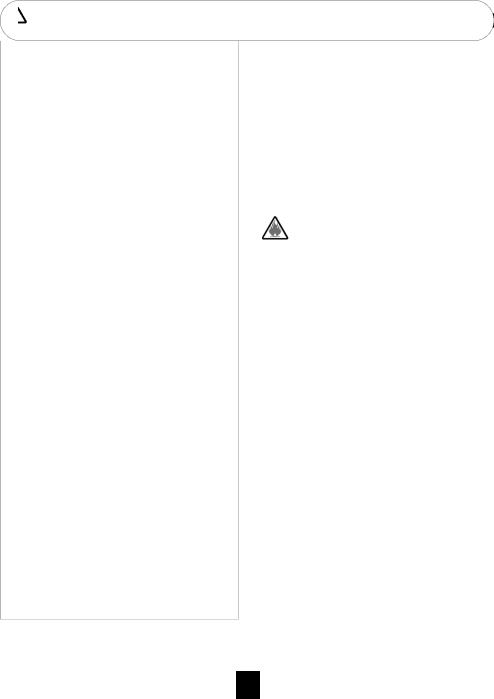
|
|
|
|
|
|
|
|
|
|
|
|
|
|
|
|
|
|
|
|
|
|
|
|
|
|
|
|
|
|
|
|
|
|
|
|
|
|
|
|
|
|
|
|
|
|
|
|
|
|
|
|
|
|
|
|
|
|
|
|
|
|
|
|
|
|
|
|
|
|
|
|
|
|
|
|
|
|
|
|
|
|
|
|
|
|
|
|
|
|
|
|
|
|
|
|
|
|
|
|
• Si lo hace, podría provocar un incendio. Si el cable de alimentación |
|
|
|||||||
está dañado, debe ser sustituído por el fabricante o una persona |
|
|
|
|
|
|
|||
del servicio posventa. |
|
|
|
|
|
|
|||
|
|
|
|
|
|
|
|
|
|
7
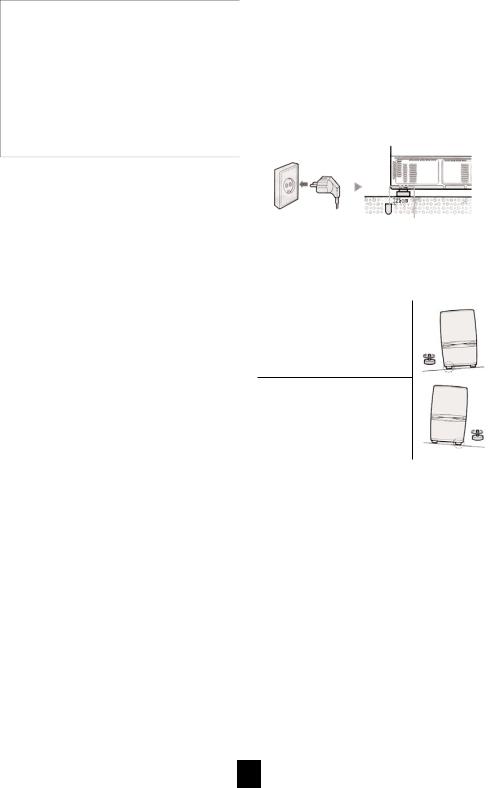
Español
No tire del cable de alimentación para desenchufarlo.
• Podría desconectar algún hilo del cableado y provocar un cortocircuito.
No coloque ningún objeto encima del frigorífico.
•Podrían caerse al abrir o cerrar la puerta, ocasionando lesiones físicas o daños materiales.
No guarde en el frigorífico productos farmacéuticos, sustancias de uso científico ni productos sensibles a los cambios de temperatura.
• Asimismo, no guarde en el frigorífico productos que requieran un control de temperaturas estricto.
No deje que los niños se cuelguen de la puerta.
No toque ningún recipiente o alimento que se encuentre en el interior del frigorífico con las manos mojadas.
•Corre el riesgo de sufrir “quemaduras” a causa del frío.
Retire cualquier objeto extraño de las patillas del enchufe.
•De lo contrario, podría producirse un incendio.
No introduzca la mano entre la base del frigorífico y el suelo.
•La base contiene bordes afilados que podrían ocasionar lesiones físicas.
Una vez que haya desenchufado el frigorífico, espere al menos cinco minutos antes de volver a enchufarlo en la toma.
•El uso incorrecto del congelador podría ocasionar daños materiales.
Si no va a utilizar el frigorífico durante un período de tiempo prolongado, desconecte el cable de alimentación.
•Cualquier deterioro en el aislamiento puede ser causa de incendio.
Evite que los niños toquen o jueguen con el panel de controles que se
encuentra en la parte frontal del frigorífico.
•Evite que los niños jueguen con el frigorífico.
•No debe subirse ni apoyarse en el panel de la base, piezas extraíbles, puertas, etc.
•Las reparaciones y el mantenimiento del frigorífico solo debe realizarlas el personal técnico cualificado. La reparación incorrecta por parte de una persona sin la cualificación necesaria puede dar lugar a situaciones de peligro que podrían tener graves consecuencias para el usuario.
•si saca cubitos de hielo o helados del congelador, deje transcurrir algún tiempo antes de consumirlos(Podría sufrir “quemaduras” debido a su baja temperatura.)
ATENCION
El refrigerante que utilizan los frigoríficos/congeladores y los gases presentes en el material de aislamiento deben desecharse siguiendo unos procedimientos específicos. Antes de desechar el frigorífico, asegúrese de que ninguno de los conductos situados en la parte posterior está dañado.
DISPOSICIÓN
INSTALACIÓN DEL FRIGORÍFICO / CONGELADOR
1.Busque un lugar apropiado e instale el frigorífico/congelador en un suelo firme y nivelado.
•Si el frigorífico no queda bien nivelado, Podría producir ruidos extraños y disminuir su capacidad de refrigeración.
2.Limpie el frigorífico/congelador.
•Utilice un paño húmedo para limpiar el interior y el exterior del frigorífico.
3.Enchufe el frigorífico/congelador en una toma mural en la que no haya conectado ningún otro aparato.
•El frigorífico debe disponer de la conexión a tierra apropiada.
4.Coloque los alimentos en el interior del frigorífico/congelador.
•Es recomendable que deje enfriar el frigorífico durante unas 2 ó 3 horas antes de guardar los alimentos.
5.Deje 60 mm de hueco entre el frigorífico y la pared trasera.
•Un espacio insuficiente causa ruido por vibración, debilita el poder de refrigeración y desperdicia energía.
6.El enchufe eléctrico debe ser accesible sin mover el frigorífico.
7.Con temperatura ambiente inferior a 10ºC, no se logrará el perfecto funcionamiento del frigorífico
ADVERTENCIA
Utilice una toma con conexión a tierra en la que no haya conectado ningún otro aparato:
•Si esta utilizando una toma que dispone de un terminal de conexión a tierra, no necesitará conexión a tierra adicional.
Uso de una toma sin conexión a tierra:
•Conecte el “cable de conexión a tierra” a la placa de cobre y entierrelo a una profundidad mínima de 25 cm.
NIVELACIÓN
Si coloca la parte frontal del frigorífico a una altura un poco superior a la de la parte posterior, podrá abrir y cerrar la puerta con mayor facilidad.
OPERACIONES PRELIMINARES
Para preparar el frigorífico para su uso y comprobar si funciona correctamente, siga los pasos que se describen a continuación.
1.Coloque en su sitio todos los estantes y compartimentos que se hayan extraído para transportar el frigorífico.
2.Limpie el frigorífico/congelador y los accesorios para retirar el polvo que se haya acumulado durante el embalaje y el envío.
3.La luz deberá encenderse al abrir la puerta del frigorífico.
4.Seleccione la temperatura más alta en el control de temperatura y deje el frigorífico en funcionamiento durante una hora. El congelador deberá haberse enfriado ligeramente y el motor deberá empezar a funcionar despacio, con un leve sonido, pero sin producir ruido. El frigorífico/congelador funciona con un compresor que lo apaga y lo enciende con el fin de regular la temperatura interna. Si el compresor es nuevo, es necesario dejarlo en funcionamiento durante un período de cinco meses. Durante este período, podría producir cierto ruido. Este es un comportamiento habitual y no implica que el frigorífico esté defectuoso.
5.Espere a que la temperatura del refrigerador sea lo suficientemente baja antes de guardar los alimentos. Deberán transcurrir algunas horas antes de que el frigorífico alcance la temperatura apropiada. Si el frigorífico no funciona correctamente, compruebe el suministro eléctrico. Si el problema persiste, consulte al distribuidor.
8
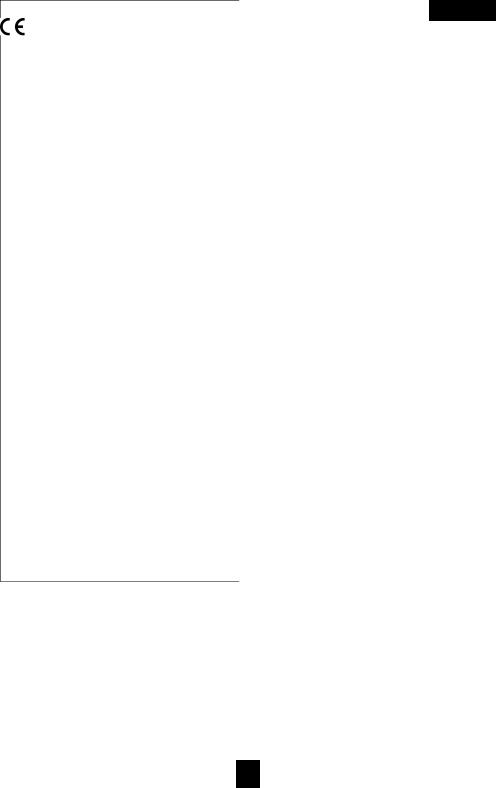
Este producto ha sido diseñado, construido y comercializado en conformidad con las Directivas 2006/95, 2004/108 y 96/57 de la UE.
Para obtener el máximo rendimiento de su aparato, debe leer cuidadosamente este manual del usuario. Conserve este manual en un lugar seguro para su posible consulta futura. Vea la solapa al final del manual para los dibujos aludidos en el texto expuesto abajo.
ANTES DE UTILIZAR EL APARATO
■Este producto está diseñado exclusivamente para uso doméstico.
■Utilice el compartimento congelador de 4 estrellas para:
-congelar alimentos frescos y cocinados,
-hacer cubitos de hielo
-conservar alimentos ultracongelados y congelados.
■Utilice el compartimento refrigerador para:
-conservar alimentos frescos,
-enfriar bebidas.
■Los compartimentos de congelación y refrigeración se descongelan automáticamente.
■Gracias a la circulación de aire frío (sistema de flujo de aire múltiple), se mantiene una temperatura uniforme en todos los estantes del compartimento de refrigeración. El compartimento de baja temperatura está especialmente diseñado para ampliar el valor alimenticio y la frescura original del alimento.
ANTES DE CONECTAR EL APARATO A LA RED
1.Después de colocar el aparato en su lugar, espere dos horas antes de conectar el mismo a la red eléctrica para asegurar su funcionamiento correcto.
2.Controlar el voltaje indicado en la etiqueta de datos(8).
3.La toma debe ser fácilmente accesible y no directamente detrás del aparato.
4.Las conexiones eléctricas deben realizarse de acuerdo con las normativas locales. El aparato debe estar conectado a tierra según prescrito por la ley (con enchufe y toma conectados a tierra). El fabricante no asume ninguna responsabilidad por daños causados a personas o animales o daños materiales resultantes del incumplimiento de este requisito.
5.La toma debe estar protegida con un fusible de 10A o superior.
6.Si el enchufe del aparato y la toma son incompatibles, la toma debe ser sustituida por un electricista cualificado.
7.Si el cable eléctrico está dañado, éste debe ser sustituido por el fabricante, su servicio de asistencia técnica o por una persona similar cualificada con el fin de evitar riesgos.
8.No utilice cables prolongadores, adaptadores múltiples, etc.
9.En ciertos países es necesario cambiar el enchufe. Asegúrese de que la instalación y las conexiones eléctricas sean llevadas a cabo por un técnico cualificado y con arreglo a
Español
(solo en algunos modelos).
las instrucciones del fabricante y las normativas de seguridad vigentes en el país. Los colores de los hilos del cable eléctrico tienen el significado siguiente:
-verde/amarillo = tierra
-azul = neutro
-marrón = corriente.
DESCONEXION
Desconectar el aparato sacando el enchufe de la toma eléctrica o, (en su caso) poniendo el disyuntor bipolar hacia arriba.
9
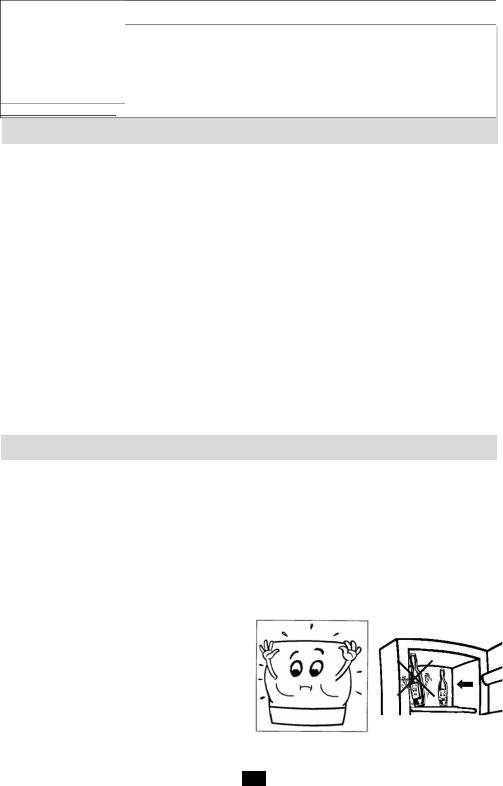
Español
Chequear la existencia de daños y el cierre correcto de las puertas.
Limpiar el interior con un paño húmedo.
No instalar cerca de una fuente de calor.
Temperatura ideal de ambiente es de +16 a +32°C.
Mantener el lugar seco y debidamente ventilado.
Esperar 2 horas antes de enchufar el aparato.
Observar la distancia mínima libre requerida para su ventilación.
Mantener las rejillas de ventilación siempre abiertas.
Desconectar siempre el aparato antes de limpiarlo o efectuar trabajos de mantenimiento.
No meter botellas de vidrio en el |
No consumir cubitos de hielo y polos |
congelador. Las botellas pueden |
inmediatamente después de ser |
explotar. |
sacados del congelador, puesto que |
|
pueden provocar "quemaduras por frío". |
Para evitar accidentes con graves |
Evite sobrecargar de alimentos el |
consecuencias, los cables electricos |
frigorífico. No bloquee las rejillas de |
deteriorados deberán ser inmediatamente |
ventilación con alimentos. Esto podría |
repuestos por un electricista cualificado. |
afectar al funcionamiento del aparato. |
No deje a los niños que jueguen o se escondan dentro del frigorífico para evitar el riesgo de quedarse atrapado o de asfixiarse.
No almacenar demasiados alimentos en la parte delantera de
las bandejas.
10

PROTECCION DEL MEDIO AMBIENTE
-El embalaje es reciclable en su totalidad, según lo confirma el símbolo de reciclaje; siga las normativas locales sobre la eliminación de residuos. fabricado con materiales reutilizables.
-Si usted decide desguazar este producto, por favor compruebe antes que el cable esté desconectado de la red. Después, corte el cable y deshágase de este producto atendiendo a las leyes locales para residuos.
-Este producto no contiene CFC’s (el circuito refrigerador contiene R134a o R600a). Compruebe la etiqueta del compresor en la parte trasera del frigorífico o la etiqueta de datos (8) en el interior del frigorífico para ver que refrigerante usa su aparato.
COMO UTILIZAR EL COMPARTIMENTO DEL FRIGORIFICO Y EL DEL CONGELADOR
Enchufe el aparato (espere 2 horas después de colocar el aparato en su sitio; consulte el apartado “ Antes de conectar el aparato a la red”). Dejar que el congelador enfríe unas 3 a 4 horas antes de meter alimentos.
-la luz del interior se enciende al abrir la puerta (del compartimento del frigorífico);
-el compresor funciona y comienza a refrigerar.
La temperatura apropiada para conservar alimentos frescos se obtiene en la posición "MID" con una temperatura de ambiente de +16 a 32 ºC.
DIAL DE CONTROL (5) DE LA TEMPERATURA
DEL FRIGORIFICO Y DEL CONGELADOR
vea la solapa al final del manual.(El dial está localizado en el interior del compartimento del frigorífico)
"LOW": temperatura más caliente que en la posición "MID" "MID": temperatura normal para conservar alimentos congelados
"HIGH": temperatura mas fría que en la posición "MID" “COOLING OFF”: Se detiene el sistema de refrigeración (sólo funciona la luz interior).
Nota: Poniendo el dial de control de la temperatura del congelador del frigorífico (5) LOW, MID, y HIGH la temperatura del frigorífico y del congelador se ajustará automáticamente.
NOTAS SOBRE LA CONGELACION Y EL
ALMACENAMIENTO
1.Aténgase a los tiempos de almacenamiento indicados por el fabricante de alimentos congelados. Asegúrese de que el paquete no presente daños.
2.Ahorro de energía: procure tener la puerta abierta el menor tiempo posible, guardando alimentos de las mismas características juntos.
3.Alimentos apropiados para congelación: carne, aves, pescado fresco, verduras, fruta, productos lácteos, pan, productos horneados, comidas precocinadas.
4.Alimentos no apropiados para congelación: lechugas, rábanos, uvas, manzanas y peras enteras, carnes grasientas.
5.Envuelva los alimentos frescos que va a congelar en las
Español
cantidades apropiadas para Ud. Para asegurarse de que la calidad de los alimentos no se deteriore, no deben excederse los pesos siguientes por paquete:
-fruta y verduras: hasta 1 kg,
-carnes: hasta 2,5 kg.
6.Escalde las verduras lavadas y cortadas (2-3 minutos en agua hirviendo; después enfríelas rápidamente regándolas con agua fría. Si las escalda en una olla de presión o en un microondas, debe cumplir las instrucciones de manejo del aparato a usar).
7.Mantenga siempre los paquetes secos para evitar que se peguen entre sí.
8.Procure que los alimentos frescos que va a congelar no entren en contacto con alimentos ya congelados.
9.No sazone con sal, ni aderece alimentos frescos o verduras escaldados antes de congelarlos. Los demás alimentos pueden ser sazonados con sal o aderezados ligeramente. La intensidad del sabor de determinadas especias puede alterarse.
10.Utilice materiales o recipientes especiales para la congelación a fin de evitar la pérdida de calidad de los alimentos durante el descongelado.
11.Anote siempre el contenido y la fecha de congelación en el paquete. No sobrepase el tiempo de almacenamiento establecido a fin de que los alimentos no pierdan calidad.
12.No congele botellas o botes que contengan bebidas carbónicas ya que podrían explotar.
13.No extraiga más cantidad de alimentos de los que vaya a necesitar inmediatamente. Una vez descongelados, prepárelos lo antes posible.
CUANDO COMPRE ALIMENTOS CONGELADOS
1.Asegúrese de que el envase no presente daños (puede que el contenido esté deteriorado). Si el paquete está hinchado o presenta manchas de líquido, puede que el producto haya sido guardado incorrectamente y descongelado parcialmente.
2.Al hacer la compra, deje los alimentos congelados hasta el final y transpórtelos en bolsas aislantes.
3.Coloque los alimentos en el congelador tan pronto como llegue a casa.
4.No congele de nuevo alimentos parcialmente descongelados. Consúmalos en un plazo de 24 horas.
5.Observe la fecha de caducidad y la información sobre el almacenamiento.
LIMPIEZA
1.Antes de proceder a la limpieza del aparato, desenchúfelo.
2.No utilice productos abrasivos. Limpie periódicamente el interior del aparato con una esponja humedecida en agua templada. El uso de un detergente con un pH neutro está permitido. Aclare y seque con un paño suave.
3.Limpie la parte exterior con un paño suave húmedo.
4.Limpie periódicamente la rejilla frontal y el radiador en la parte posterior con una aspiradora o un cepillo.
DESUSO PROLONGADO
1.Vacíe los compartimentos del frigorífico y del congelador.
2.Desconecte el aparato.
11
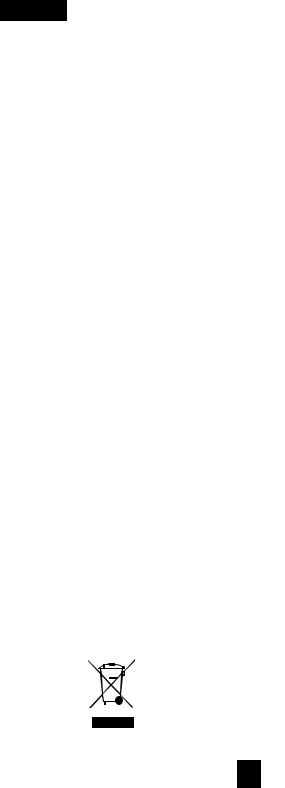
Español
3.Limpie y seque ambos compartimentos.
4.Deje las puertas abiertas para evitar que se formen olores desagradables.
SERVICIO DE POSTVENTA
Antes de contactar nuestro servicio de postventa:
1.Intente solucionar el problema (consulte el apartado “Guía de diagnóstico de averías”).
2.Vuelva a conectar el aparato para comprobar si se repite el fallo. En caso afirmativo, desconecte el aparato y vuelva a conectarlo después de transcurrida una hora.
3.Si el mismo fallo se repite, póngase en contacto con nuestro departamento Atención al Cliente, especificando:
-el problema,
-el número de modelo del aparato,
-el número de servicio (véase la etiqueta de datos 8),
-su dirección completa, número de teléfono y código postal.
Nota: el cambio de la dirección de apertura de la puerta efectuado por nuestro Servicio al Cliente no queda cubierto por la garantía.
GUIA DE DIAGNOSTICO DE AVERIAS
1. El aparato no funciona. Compruebe si:
-existe un fallo de alimentación,
-el enchufe está correctamente insertado en la toma,
-(si es aplicable) está conectado el disyuntor bipolar,
-el cable de alimentación está dañado,
-el termostato está ajustado correctamente (5).
2.La temperatura dentro de los compartimentos no es lo suficientemente fría. Compruebe si:
-las puertas cierran debidamente,
-el aparato está instalado cerca de una fuente de calor,
-el termostato está ajustado correctamente (5).
-la circulación de aire está bloqueada.
3.La temperatura en el compartimento del frigorífico es demasiado fría. Compruebe si:
-el termostato está ajustado correctamente (5).
4.La luz interior no funciona. Consulte el punto 1 y después:
-desconecte el aparato de la toma.
-compruebe si la bombilla está fundida, y si es necesario, cambiarla (max.15W)
-para cambiar la lámpara primeramente quitar la protección “translucida” presionando la parte inferior y tirando hacia afuera.
-quitar la lámpara y sustituirla por una nueva.
-finalmente colocar de nuevo la protección “translucida”.
INFORMACIÓN DEL EMPAQUETADO DEL
FRIGORÍFICO
Todo el material de empaquetado respeta el medio ambiente. Pueden ser depositados en la basura o quemados en una planta de incineración sin ningún peligro.
Materiales usados: Los plásticos pueden ser reciclados y se identifican de la siguiente manera:
■PE : polietileno,, ej. La bolsa interior que cubre el frigorífico.
■PS : poliestireno, e.j. los protectores, que están libres de fluoroclorocarbono.
El embalaje de cartón esta hecho de papel reciclado y debe ser depositado en contenedores de papel reciclado.
ELIMINACIÓN DE ANTIGUOS APARATOS
Por razones medioambientales, los aparatos frigoríficos deben ser desechados adecuadamente. Esto es aplicable a su viejo aparato, así como a sus nuevos aparatos.
Atención! Antes de deshacerse de sus viejos aparatos, deben hacerlos inoperativos. Desconecte el enchufe de la red, corte el cable y elimine cualquier cierre. Esto elimina el peligro de que los niños puedan encerrarse en su interior.
Eliminación:
•El aparato no debe ser desechado con el resto de la basura..
•El circuito de refrigeración, especialmente el intercambiador de calor en la parte trasera del frigorífico no debe ser dañada..
•Usted puede obtener información sobre horarios de recogida de estos aparatos en su ayuntamiento o autoridad más cercana.
ATENCION
La lámpara del frigorífico puede encontrarse desconectada incluso aunque las puertas no esten completamente cerradas.
Nota: Es normal que los bordes de la puerta del frigorífico y la parte frontal del mismo se calienten, esto está pensado para evitar la formación de condensación.
Los ruidos de gorgoteo, etc., en el interior del circuito del frigorífico son normales.
El volumen util máximo del aparato se obtiene al retirar todos los cajones del compartimento congelador con excepción del cajon inferior y con sólo tres estantes en el compartimento refrigerador.
Este electrodoméstico no está pensado para ser usado por personas (incluyendo niños) con las capacidades físicas, sensoriales o mentales reducidas o experiencia y conocimientos escasos, a menos que hayan recibido instucciones para su utilización o lo hagan supervisados por una persona responsable de su seguridad
Eliminación de equipamiento eléctrico y electrónico usado
Este símbolo en el producto, sus accesorios o embalaje indica que el producto no debe tratarse como un residuo doméstico. Deshágase de este equipamiento en su punto de recogida más cercano para el reciclaje de residuos eléctricos y electrónicos. En la Unión Europea y otros países europeos existen diferentes sistemas de recogida de productos eléctricos y electrónicos usados. Al asegurar la correcta eliminación de este producto ayudará a evitar riesgos potenciales para el medio ambiente y la salud de las personas que podrían tener lugar si el producto no se eliminara de forma adecuada. El reciclaje de materiales ayudará a conservar los recursos naturales. Por consiguiente, no elimine equipamiento eléctrico y electrónico usado junto con residuos domésticos. Para información más detallada acerca del reciclaje de este producto, póngase en contacto con su oficina municipal, el servicio de eliminación de residuos domésticos o el establecimiento donde adquirió el producto.
12

DAEWOO GARANTIA
E L E C T R O N I C S
DAEWOO ELECTRONICS EUROPE GMBH (SPANISH BRANCH)
Edf. Inblau A, C/. Selva, 10, 2.º - Mas Blau Business Park Tel. 902 13 30 30 - Fax 93 262 30 02
Web: www.daewoo-electronics.es
08820 EL PRAT DE LLOBREGAT (Barcelona)
Estimado Cliente:
Gracias por adquirir este producto DAEWOO
Rogamos conserve esta Tarjeta debidamente sellada y rellenada por el Distribuidor.
En caso de avería, dentro del plazo de garantía, muestre esta Tarjeta al Servicio Técnico DAEWOO.
Antes de avisar al Servicio, rogamos revise el Manual de Instrucciones.
|
|
A |
Ñ |
|
S |
|
O |
S |
O |
|
|||
|
|
|||||
|
|
|
|
D |
||
|
|
|
|
|
E |
|
D |
|
|
|
|
|
|
G |
|
|
|
N |
T |
I A |
|
|
|
||||
|
|
|
||||
|
|
|
||||
A |
A |
|
||||
|
|
R |
|
|
|
|
E L E C T R O N I C S
*$5$17,$
Número de serie:
Modelo:
DAEWOO ELECTRONICS EUROPE GMBH (SPANISH BRANCH)
